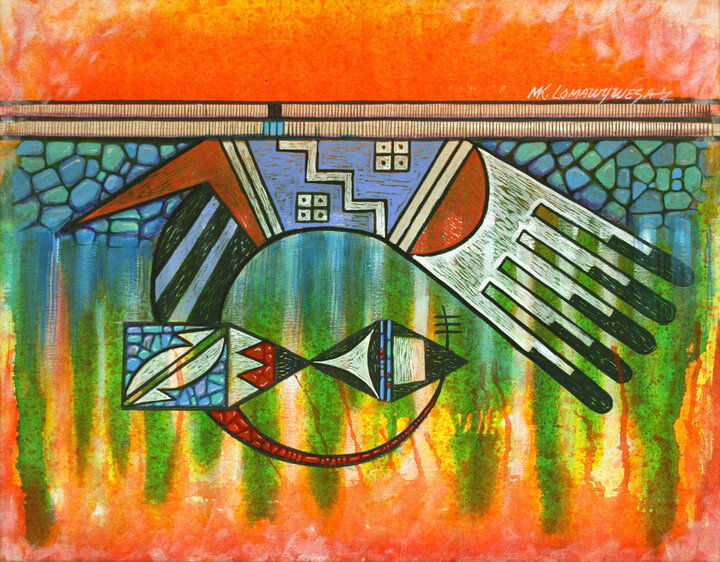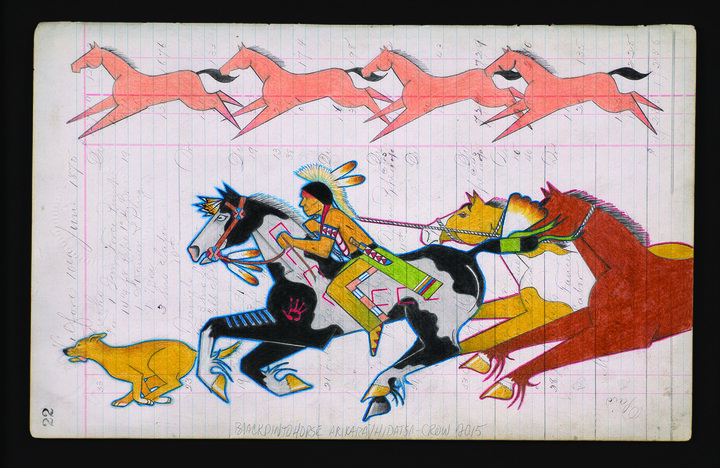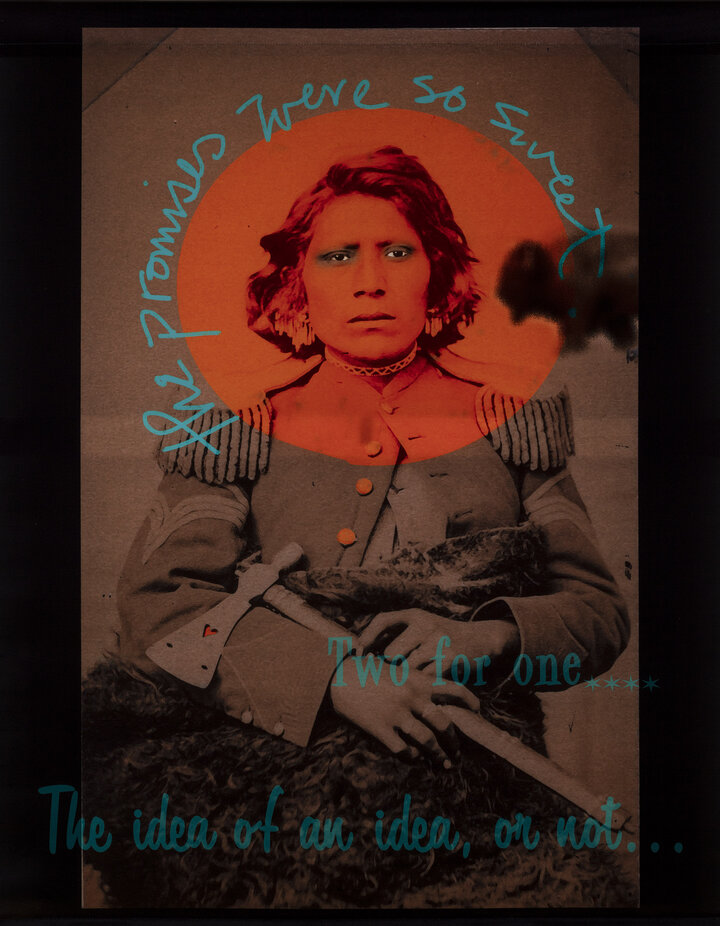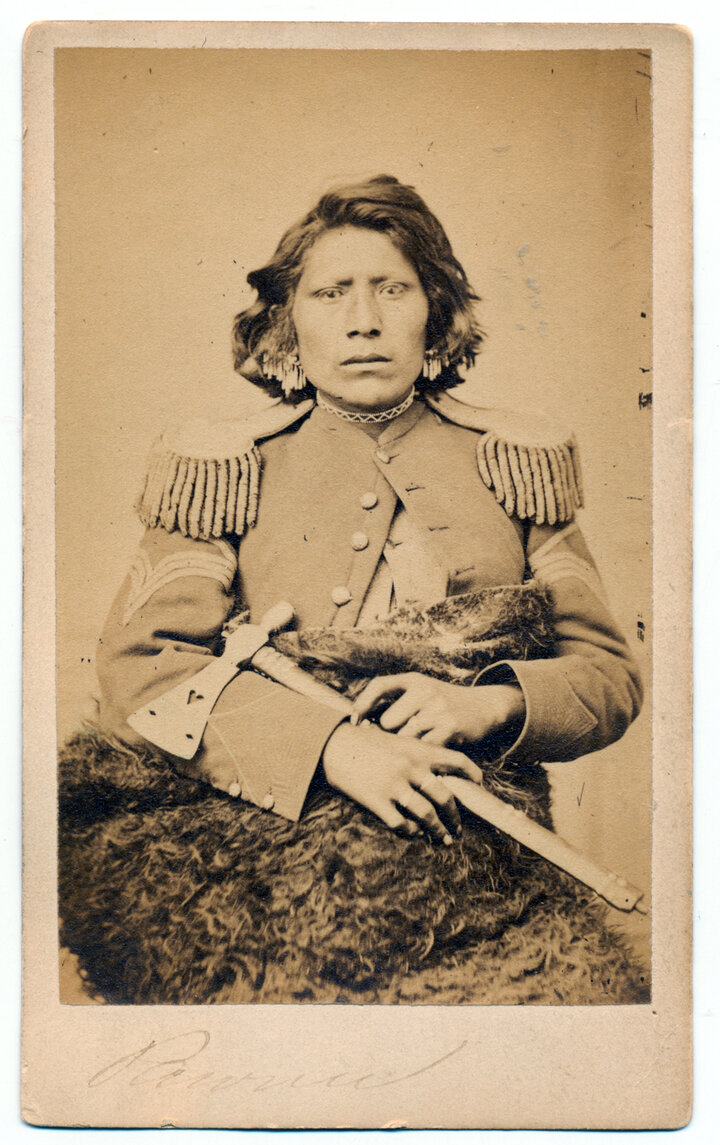The University of Nebraska is a land-grant institution with campuses and programs on the past, present, and future homelands of the Pawnee, Ponca, Otoe-Missouria, Omaha, Dakota, Lakota, Kaw, Cheyenne, and Arapaho Peoples, as well as those of the relocated Ho-Chunk, Sac and Fox, and Iowa Peoples.
The mission of the Great Plains Art Museum is to collect, preserve, research, and interpret the art and literature of the Great Plains region and, together with the Center for Great Plains Studies, to foster the study and appreciation of the diverse histories, cultures, and lands of the Great Plains of North America.
The museum’s collection currently holds over 130 artworks made by artists from diverse Great Plains and Southwest Indigenous tribes. The artwork reproduced on our building’s exterior was installed as part of an initiative to share this growing art collection with the public and to remind viewers of the ongoing presence and vitality of Indigenous peoples in our region.
East banner:

Daniel Long Soldier
Oglala Sioux
b. 1949, Pine Ridge, SD
The Plainsman
1992
oil on canvas
35 ½ x 23 ½ inches
Gift of the Friends of the Center for Great Plains Studies
© Daniel Long Soldier
Daniel Long Soldier is a self-taught artist who works with a variety of media, including pen and ink, charcoal, acrylic, and gouache. Long Soldier’s artworks tell a story, and evoke the history and spirituality of his people. He feels that his talent is a gift from the Great Spirit, stating, “I like to say, He (The Great Spirit) does all the work, I just clean the brushes.”

Christine Musgrave
Osage Nation
b. 1959
Bear Dance
1990
oil pastel, ink, acrylic, and collage
22 ½ x 47 ½ inches
Gift in memory of George M. & Helen G. Buffet
Christine Musgrave’s Bear Dance incorporates many of her influences, which include quilts, Native hide painting and rock art. She notes that “an idea that interests me is that of the rock where different peoples of different tribes, spanning 1,000 years, came by to leave their marks and messages with the tools they had available to them. With that in mind, I am scratching, drawing and paintings away with all that is available to me.”

Michael Kabotie (Lomawywesa, which means “Walking in Harmony”)
Hopi
b. 1942, Shongopovi, AZ; d. 2009, Flagstaff, AZ
Turquoise Bird
1974
acrylic on canvas
15 ½ x 19 ¾ inches
Gift of Patricia Janis Broder and Stanley H. Broder
Michael Kabotie was one of the founding members of Artist Hopid, a group that used their art to share Hopi culture with the public. Turquoise Bird takes inspiration from Hopi jewelry—more specifically, as Kabotie has noted, the work of Hopi jeweler Charles Loloma. Here, we see turquoise and coral adorn a bird rendered in the style found on pottery from Sikyátki, a former Hopi village.

Monte Yellow Bird Sr. (Black Pinto Horse)
Arikara/Hidatsa
b. 1960, Garrison, ND
Say,…My Friend and I Burrowed Some of Your Ponies
2015
colored pencil on circa 1875 Milford, CT ledger
8 ¼ x 13 ¼ inches
Purchased through the generosity of the Woods Charitable Fund
© Monte Yellow Bird Sr. Black Pinto Horse
Monte Yellow Bird considers himself a “painter nurturing and sharing the true Indigenous heartbeat.” Many of Yellow Bird’s artworks are contemporary versions of ledger art, a practice that emerged in the late nineteenth century when ledger or account books became available as a medium on which Native people could visually record their history. Here, he renders this scene with bold line and color, depicting a lone rider galloping along with two horses in tow, accompanied by a dog (presumably his “friend” mentioned in the title) who leads the group.

Hulleah J. Tsinhnahjinnie
Seminole/Muscogee/Diné (Navajo)
b. 1954, Phoenix, AZ
The Promises were so sweet
2010
digital print on poly-satin
60 x 48 inches
Museum purchase
© Hulleah J. Tsinhnahjinnie
In 2011, Seminole/Muscogee/Diné artist Hulleah Tsinhnahjinnie collaborated with the Great Plains Art Museum to create digital collages based on historical photographs from the museum’s permanent collection. Titling her series “Double Vision,” Tsinhnahjinnie reclaimed these images taken by white photographers and created new documents grounded in a Native perspective.
The Promises Were So Sweet is based on a photograph of a Pawnee man taken by Western photographer William Henry Jackson (below). With vibrant color, Tsinhnahjinnie draws attention to the man’s face and frames it with the titular text that references the promises made and broken to Native people. Regarding this series, the artist notes that “It is my hope that these new works present a visual confrontation, an argument with premises that should be critically reviewed and endlessly questioned.”

William Henry Jackson
b. 1843, Keeseville, NY; d. 1942, New York, NY
Murie, Pawnee Scout
1868–1870
albumen print
3 ½ x 2 1/8 inches
Gift of Dr. John and Elizabeth Christlieb